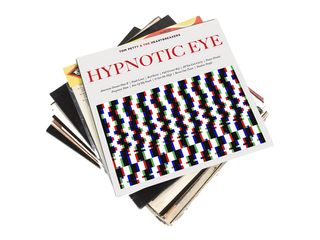
Mike Campbell on Tom Petty And The Heartbreakers' new album, Hypnotic Eye
Anybody expecting Tom Petty And The Heartbreakers to back down from the album format can forget it. On Hypnotic Eye, the band's 13th studio effort, they reaffirm their commitment to the long-player in the best possible way: by turning in a wall-to-wall set of feisty, scrappy and impassioned rockers that feels like a watershed, easily recalling the youthful zeal of their early releases while still delivering fresh sonic surprises and lyrical revelations.
“It's just the way that we make music, by making albums," says lead guitarist Mike Campbell. "The album format is what we grew up on. It’s what we aspired to when we were first discovering music – it’s what's what we know. We actually talked about this because nowadays, with iTunes and everything, there's a lot of pressure to get this track and that track, whatever. We really made an effort to fight that as much as possible and present this as an entire piece. Also, we kept the number of songs down to a good album length, not the mega-anthologies people put out now."
Coming after the Chicago blues-based sound of 2010's Mojo, Hypnotic Eye may be viewed by some as an about-face by the band, a decided return to straight-up rocking. But Campbell explains that the only agenda the Heartbreakers follow is to have no agenda at all.
“The songs inform what we do, typically," he says. "We've never come in and said, ‘This is the type of album we want to make,’ as far as I can remember. Sometimes, halfway through, we might have a discussion – ‘This is taking this sort of shape. Let's think about this in these terms now.' The only plan we had is that we wanted it to be as live as possible, with the band all playing at once. Aside from that, we had no preconceptions.”
The Heartbreakers – which, in addition to Campbell and, of course, Petty, includes keyboardist Benmont Tench, bassist Ron Blair, drummer Steve Ferrone and multi-instrumentalist Scott Thurston – spent the better part of three years tracking Hypnotic Eye, most of it at at the band's LA rehearsal space/recording facility, The Clubhouse (additional work was done at Petty's Malibu home studio, Shoreline Recorders; engineer Ryan Ulyate, who co-produced with Petty and Campbell, mixed the record at his home studio, Ryan's Place).
"It's totally organic at The Clubhouse," Campbell says. "We play as a band, with no headphones. If you're really careful to keep the monitors not too loud, if you're lucky, you get a little bit of nice bleed between the instruments. The guitars might spill a little bit into the drums, or the drums might spill a little bit onto the piano. Just a little bit of that makes a glue for the whole thing to sound more real."
Campbell started the Hypnotic Eye sessions with the same 1959 Gibson Les Paul Standard that he used for "probably 100 percent of the Mojo record." As time went on, however, he began to experiment with other makes and models. "New songs would come in, and I would sneak in a different guitar without Tom looking," he says with a laugh. "And then we opened up and let some of the other instruments in to add different colors."
Campbell's amp setup in The Clubhouse is one that he stumbled upon while playing gigs with his side band, The Dirty Knobs – a 1954 Fender Tweed Deluxe and a 1964 Fender Blackface Princeton. “I hit on that combination and started to really like it, so I started using it with the Heartbreakers." he says. "Those two amps complement each other beautifully. If I need more brown, darker sounds, I’ve got the Deluxe, and if I want clarity, I can get it out of the Princeton. Occasionally, there might be a Leslie guitar or something else kind of special, and for some overdubs we might pull in a different amp. But basically, it's just those two amps. That's the sound."
Tom Petty And The Heartbreakers' Hypnotic Eye will be released on July 29. You can pre-order the album here. On the following pages, Mike Campbell runs through the new set track-by-track.
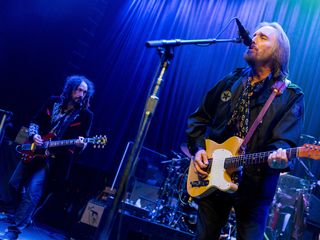
American Dream Plan B
“It’s a tough guitar sound. That’s the setup I was talking about – the Princeton and the Deluxe. The main riff is me and Tom playing that riff together. I think that's Scott, too. He might have been tripling that lick. That's the basic setup.
“I tried to play all the solos live on the floor. For this song, I had a solo off the top of my head, and as we were putting the track together, we thought, ‘Maybe we could try something a little brighter here.’ So that solo was an overdub with the Les Paul.
“I love Tom’s lyrics on this one; he did such a great job. For 95 percent of the songs, I’d say, there were no demos. Tom would come in, play it down, and we’d all listen. Then we’d all join in and arrange it as we went. Usually, by the time we knew what the chords were and everything, we would play it once or twice, and that would be the track.”
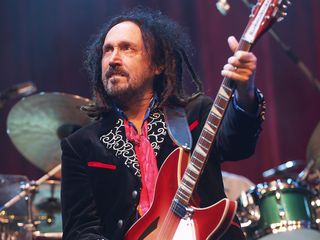
Fault Lines
“The rhythm is a bit like Ray Charles’ What’d I Say. ‘Ding-ding-ding-dee-ding-ding-dee-ding’ – it's got that top part on the rhythm. That's where The Beatles got I Feel Fine from – that's what George told me. It’s kind of rumba or something, and then you put a rock beat under it.
“It's something we've never done before. Typically, we keep our rhythms pretty simple in form – 4/4 four and basic. This one, we wanted to have a little bit of a different groove. We tried that kind of thing over the top, against the lower beat, and it worked really well.
“Now, this is one that we actually did demo for. Most of the songs that I write – I wrote this with Tom – I’ll demo at home, usually. So we do with work a template. Then Tom, if he likes it, will write words and we'll go on and play it with the band.
“My demo had a different chorus. When Tom got it, he said, ‘I want to change the chords in the chorus because I want to sing there. We put a new chorus in it with him playing most of the rhythm guitars. He did a great job on the lyrics, as always.”
“It's interesting, the main guitar, the stabbing guitar and the wah-wah guitar, was this model that we hardly ever play, but I pulled it out that day. It's a Fender Thinline, kind of semi-hollow body, butterscotch-looking thing. On this track, I actually used a Marshall mini amp, about the size of a Princeton. The room I was in really made that sound – I got lucky that day.”
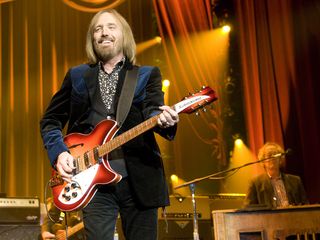
Red River
“When Tom brought it in, he was calling it Mad River. Later on, I think, wisely, he came up with Red River. I don't know if it was directly from the film – probably not. He might have just been trying to find a word that rolled off the tongue better.
“We started with a live track. Certain parts and sections got added, but we kept the basic groove of the original track. So it's not like a Frankenstein monster or anything – it still has the basic juice of a soulful take. That happens with songs. Sometimes you live with them for a while and you think, ‘The bridge is not as good as the chorus. Maybe I ought to change these chords.’ We've done that before in the past, where we just come in and decide to drop whole new chords in months later on the chorus. If you're careful, you can do it where it's relatively seamless.
“It sounds like a nylon-string guitar in the solo, but it’s a Gibson J-160, like The Beatles used to use. We were at Tom's house one day and we did that as an overdub. We put that through an amp with a lot of reverb.
“I also use a B-string bender on that solo. There was a live solo on the floor with a Gibson, a little more bluesy, but then we thought, ‘The song is taking this kind of a turn. Maybe we could put something in there that has a little more bite to it.’ I got the B-string bender out, which I love playing. It leads you to a lot of cool rock-out type scales and things.”
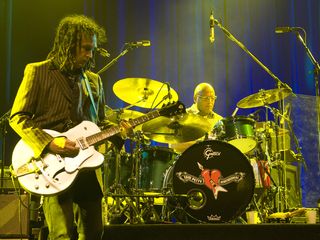
Full Grown Boy
“I always try not to overplay. I hate hearing records where the guy's playing all over the place. Basically, what I do is, I really listen to the song without playing. When Tom is showing a new song to us, I listen really closely to the spaces between the words and the chords.
“When I first heard this song, I thought, ‘This sounds like J.J. Cale.’ I was thinking sort of like, ‘If I was J.J. Cale, how would I approach this?’ It seemed to have his spirit in it. I love the way he plays. Talk about economical – he’s really good at that. I think I was trying to honor him in my approach to that guitar part, to just keep it simple.
“The other trick is get into the soul of the singer and listen to the way he's phrasing his melody. And maybe you can hear a little line in there that you can try to play on the guitar to simulate that. Sometimes that leads you into maybe not the same line, but something that's really complementary to where the guy's coming from.
“The solo is the Les Paul. I’m on the bass pickup, and at one point it changes a little bit. I was just going for a mellow, kind of swampy J.J.-type of feel on it, in my point of view.”
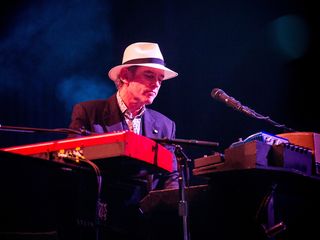
All You Can Carry
“This one came together pretty much the same way the other ones did – we learned it in the studio. I think we cut it twice. The first time we cut it, it was a little slower, but it just didn't quite get off the ground. We came back in about a week later and said, ‘Let's try that one again and kick it up a little bit.’
“It's got some nuances to it, like in the bridge, where it lightens up and opens up a little bit for some space. Really great lyrics. I like the way Tom sings this one.
“The solo’s got some interesting parts. I was probably just following Benmont. [Laughs] He's so great on stuff like that. If I ever get stuck, like, ‘I don't know what to do here,’ I listen to him. There's so many great overtones and things coming off his keyboard. Sometimes that just tells me what my part should be.”
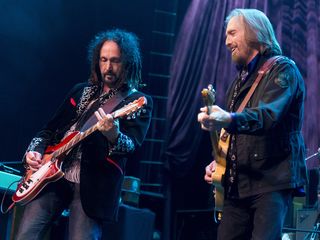
Power Drunk
“This is one of my favorites. The whole vibe of it and the guitar – it reminds me a little bit of a song we did on our first album called Fooled Again. It's got this languid, slow vibrato along with a badass lyric, and then the guitar is cool and blues-y. I just really enjoyed playing this song.
“From the solo, there’s the chordal part; that’s from a part that Tom wrote for the bridge. They’re hard chords, and there's almost a dissonant chord in the middle. But it all works. I really like it.”
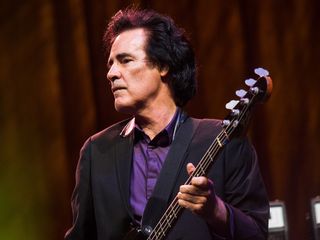
Forgotten Man
“Ryan really did a lot with this track. We approached it with this Bo Diddley-like rhythm and tremolo. Now, vibrato can really get out of control throughout a song, especially if the tempo of the vibrato wavers a little bit against the rhythm. It can be a bit of a problem.
“Anyway, we cut it, got the vibe, and it was a little messy here and there. Ryan somehow found a way to tidy it up for us so that it all worked together. He worked really hard on it to get the thing to groove.
“After we cut it live, I think the bridge on the floor was just the chorus with some kind of solo in it. Then I came in one day when we were working on overdubs, and Tom said, ‘I got this new idea for the middle. It was getting kind of messy, so I thought we put a little acoustic break.' He wrote a little acoustic thing to go in the middle, and we inserted that into the track; that was all his idea. It worked out really well. You get a little break from the rocking thing, and then the solo comes in after.”
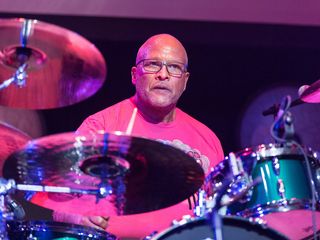
Sins Of My Youth
“Steve Ferrone is so good on this. He really makes it. This song was a little tricky because it's delicate, but it's also got to be tough, so there’s a balance. We used to call it the ‘bossa nova track’ because it has that stick to it.
“We were working on the drum part and we knew that we wanted a certain vibe, and on that day this guy shows up with a Magnatone amplifier. It had a stereo vibrato/tremolo thing, which is really unique for one of their amps.
“Tom just got a Gretsch guitar, so he plugged it into the amp and that was the sound that we were looking for. It just happened to show up on that day. There's a lot of space in the song, mostly just from that one guitar, drums, bass and vocal.”
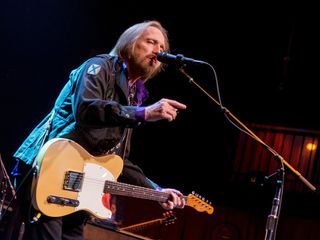
U Get Me High
“This was an old song, actually. Tom was going through the old catalog – occasionally, songs get half-written or we never finish them. I think he said this one was from the Wildflowers period. He discovered a demo of it. It was near the end of this album, and he thought that he could finish it and it would be good for the band. It ended up great.
“The rhythm guitar is Tom on a Telecaster. Then he plays a little first fuzztone somewhere near the end, and then there's a high guitar – I think that was my Les Paul. The basic rhythm track is just Telecaster.
“About halfway through the album, Fender brought this amp in called the Excelsior. It's like a vintage amp – it has two knobs on it and a 15-inch speaker. We used it on some of the overdubs. We liked it so much, we're going to make it a Heartbreakers model. We're going to call it the ‘Heartbreakers amp.’"
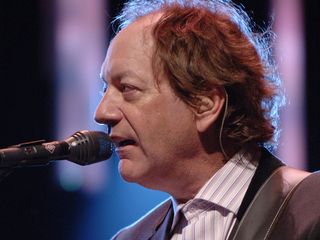
Burnt Out Town
“I'm glad this song made the record. When we first started the album, we were doing a lot of songs in what I would call the John Lee Hooker/Jimmy Reed vibe – really old, deep kind of blues. For a while, I was really thinking, ‘This is going to be great. This whole album is going to be like this.’
“Of course, then it took a left and then a right and then a left, and it went on. This song survived from the first batch. I like it, in particular, because of its simplicity. Tom wrote some great words for it. I especially like the intro, where he talks a little bit.
“The guitar I'm using on that is a Kay, a Barney Kessel Kay, I think, from '56. It’s a big fat thing. It looks like Art Deco refrigerator with ornaments on it. A really beautiful, deep-sounding guitar. It works for that John Lee Hooker approach: Just get the groove, stay on it, and get the deep, swampy tone.
“No solo – it didn't need one. There's little licks here and there, but you wouldn’t have a solo on a John Lee Hooker record – hardly on a Jimmy Reed record, either. This song is all about the tone and the groove and the guy singing. There's no room for any showboating.”
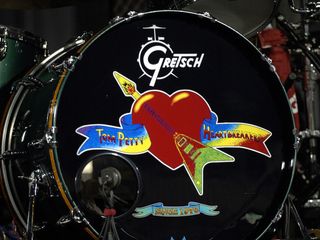
Shadow People
“The riff is one that Tom wrote. It's a hammer-on riff and is, for the lack of a better reference, kind of a Neil Young riff, I guess. It just ties the chords together in the chorus. Tom came in with it already as part of the song.
“Benmont might have played some mellotrone vibes or something in the bridge. I think maybe we had that Gibson acoustic into the amp with the reverb. Ben and I, we're telepathic. [Laughs]
[Asked about the lyric "I ain't on the left, I ain't on the right. I don't have a dog in this fight."] “That is as political as we get. I love that line because it's a lot like Dylan lines, because you'll set the rhyme up and you'll be expecting the obvious rhyme punchline. I did not hear ‘I don't even have a dog in this fight" coming. I thought that was so cool. That's the best line that you could put in there. Tom is pretty astute.”

Joe is a freelance journalist who has, over the past few decades, interviewed hundreds of guitarists for Guitar World, Guitar Player, MusicRadar and Classic Rock. He is also a former editor of Guitar World, contributing writer for Guitar Aficionado and VP of A&R for Island Records. He’s an enthusiastic guitarist, but he’s nowhere near the likes of the people he interviews. Surprisingly, his skills are more suited to the drums. If you need a drummer for your Beatles tribute band, look him up.

"Reggae is more freeform than the blues. But more important, reggae is for everyone": Bob Marley and the Wailers' Catch a Fire, track-by-track

“Part of a beautiful American tradition”: A music theory expert explains the country roots of Beyoncé’s Texas Hold ‘Em, and why it also owes a debt to the blues

"Reggae is more freeform than the blues. But more important, reggae is for everyone": Bob Marley and the Wailers' Catch a Fire, track-by-track

“Part of a beautiful American tradition”: A music theory expert explains the country roots of Beyoncé’s Texas Hold ‘Em, and why it also owes a debt to the blues
Most Popular







